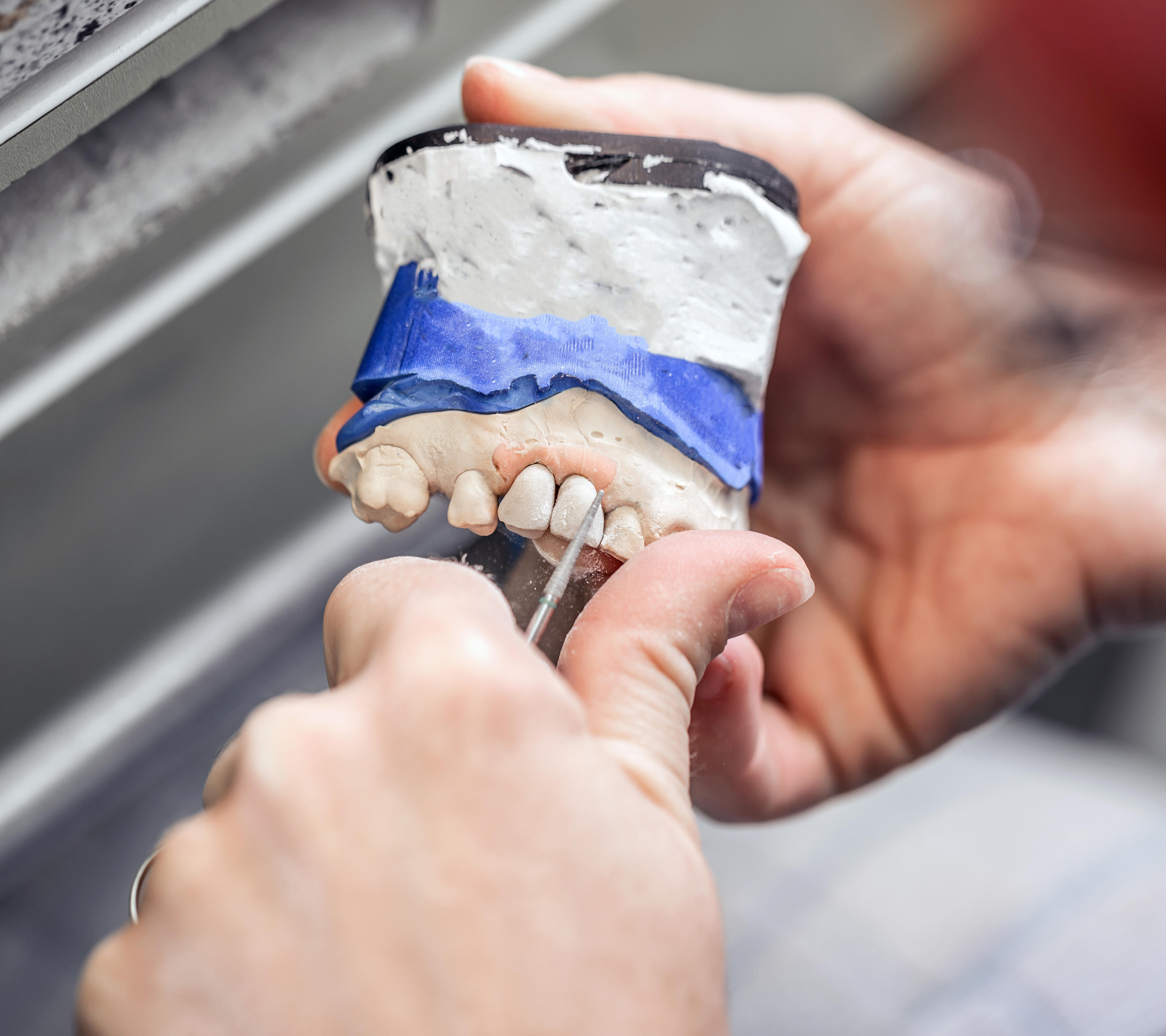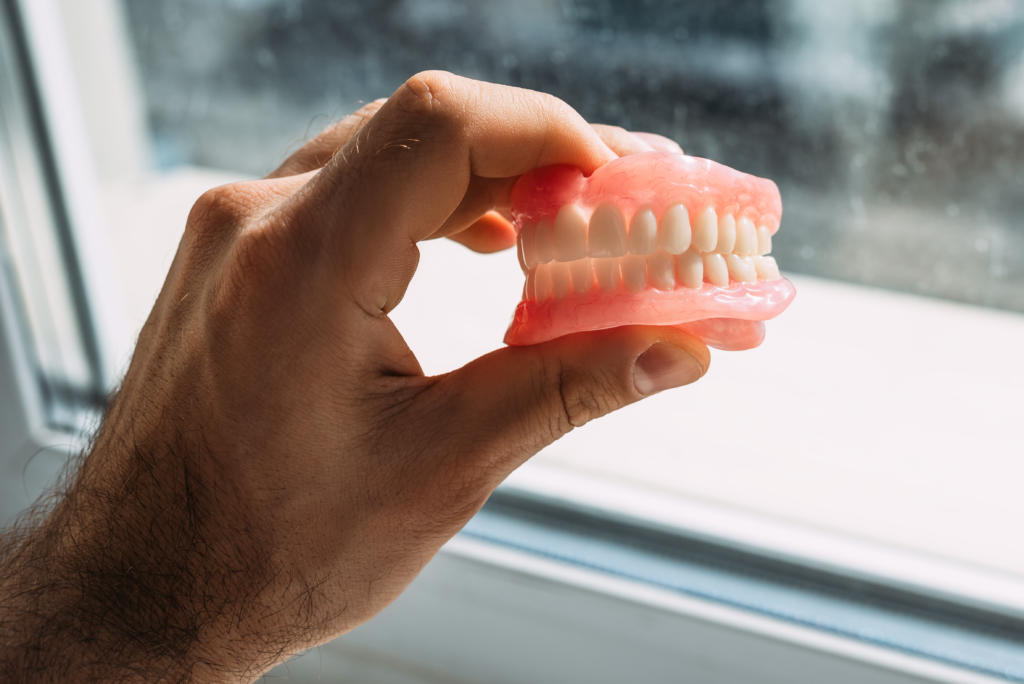
How Are Dentures Made? A Unique Process for Unique Teeth
How are dentures made? This is a common question that dental professionals hear all of the time. While some patients believe that a room exists in the dental office filled with shelves of dentures to try, nothing could be further from the truth.
The fact is, each denture is custom-made, especially for you, to meet your specific needs and restore the form and function that natural teeth originally provided. Let’s eliminate the mystery to better understand what happens when the dentist takes impressions of your mouth.
How Are Dentures Made Traditionally?
Dentistry borrows its traditional denture-making process heavily from jewelry casting by creating reverse images to duplicate existing pieces. In dentistry, a reverse image of your existing teeth or gums is the basis for denture impressions. The steps for making dentures are outlined as follows:
Impressions Are Taken
Impressions are taken to accurately represent the current state of your mouth. If you have no teeth at all, the impressions will record the gum tissue and surrounding structures. If you plan to have teeth removed for immediate denture placement, the impressions will include your remaining teeth as well as your gums.
In addition, the denturist will collect a bite registration, a record of how the upper and lower arches relate to one another.
Model Is Made and Put on an Articulator
Models are made from the impressions by pouring a slurry of laboratory plaster into the impressions. Once this plaster-of-paris-like material hardens, the impression material is removed, and the laboratory technician is left with a life-sized representation of your mouth.
The technician then uses the bite record to determine how the upper and lower models relate to one another in space. These models, with the bite registration in place, are mounted onto an articulator, a mechanical device used to simulate the movements of your jaw.
Wax Try-In Created
After mounting, the bite registration is removed from the models. Stock denture teeth are selected and set in a wax base on the plaster models. The lab technician carves the wax and creates forms representing how the dentures will look when completed.
The wax forms are tried into your mouth to allow the dentist to check the tooth arrangement, bite, and overall fit. If changes are necessary, the dental professional will make them accordingly.
Wax Is Carved
Once the mockups of your dentures have been tried into your mouth, the wax forms are put back on the articulated models and carved to represent the fine details of the gum material, extending the length of the flanges and sealing the wax onto the models. The models with completed carvings intact are removed from the articulator and placed into a two-piece metal flask.
Dentures Are Set in a Flask
The wax dentures are completely covered with laboratory plaster that is allowed to harden so that the shape of the denture teeth and wax is preserved. Boiling water is used to soften the wax. The flask is opened to remove the wax, revealing a reverse image of the wax pattern in plaster while the denture teeth remain in place.
Acrylic Is Injected into Plaster Mold
The two sections of the flask are cleaned to remove traces of wax, followed by an application of a liquid separator to prevent acrylic from sticking to the mold. Liquid acrylic is injected into the space left by the removal of the wax to create an exact replica of the gum material. The flasks are exposed to heat and pressure, allowing the acrylic to take on a solid state.
Plaster Is Removed
Flasks are allowed to cool prior to opening. Models and plaster are removed using a mechanical device that operates much like a miniature version of a jackhammer. Once most of the plaster has been removed, plaster remnants are eliminated by placing the dentures into an ultrasonic bath.
Dentures Are Trimmed and Polished
At this point, the dentures look rough and usually have excess acrylic present that must be trimmed to give the dentures their characteristic shape. Final refinements to the surfaces are made. The dentures may be placed back onto the articulator to refine the bite before final polishing and high shining to a slick, smooth finish that is easily cleansable.
Initial Fitting
The finished dentures are seated into your mouth. The denturist will make further refinements at chairside to improve their fit, comfort, and bite while eliminating any areas that are a potential source of irritation. Since traditional denture-making utilizes two complete sets of reverse images to transform the impression into a finished denture, there are several places where errors can be introduced and carried through the entire process.
Adjustments are necessary to correct these errors and are a normal part of getting new dentures. If you are having immediate dentures placed after your natural teeth are removed, the number of steps involved in making dentures will be somewhat abbreviated as some guesswork is involved in completing the immediate denture.

An elderly man holds a denture. A man is holding dentures in his hands. Removable dentures flexible. False teeth. Implant. Orthodontics. Old age. Teeth. Jaw. The close plan. Removable denture
Digital Dentures: The Next Generation of How Dentures Are Made
How dentures are made digitally heavily relies on the use of computer-aided technology borrowed from the manufacturing sector to create dentures that have a much more exacting fit and are not prone to many production errors associated with traditional dentures.
Impressions
Impressions may be taken using traditional impression materials or may involve the use of an intraoral scanner to directly capture the topography of the inside of your mouth. If physical impressions are utilized, the impressions are then digitized using a 3D impression scanner.
If your impressions were taken with an intraoral scanner, the necessary data to create models of your mouth is transferred electronically to the dental laboratory.
3D Scans and Try-In
Dental software constructs virtual articulated models of your mouth that can be rotated and viewed in any orientation. Laboratory technicians use this software to design and create a mockup of the dentures that can be verified in your mouth, much like a wax try-in.
Any necessary modifications are made within the software to produce the final dentures’ design, controlling parameters such as thickness, tooth angulation, lip fullness, and other aesthetic factors.
Production
Design software is then used to drive the production via milling of pre-cured resin or 3D-printing of the denture bases and teeth from their respective materials. The teeth and base components are joined post-manufacturing by hand, trimmed, and polished for delivery.
Longevity
High-quality resins and fewer processing imperfections mean that digital dentures last longer and need fewer repairs than traditionally-processed dentures. Most digital dentures are designed to last approximately 10 years, depending upon how they are cared for at home.
Fewer Appointments
Because there are fewer processing errors, digital dentures fit much more comfortably and precisely than traditional dentures, with minimal adjustments upon or after delivery.
See Also: What Are Digital Dentures and How They Work
FAQs About How Dentures Are Made
The denture-making process is complex. Here are some common questions about this involved process.
What Are Dentures Made Of?
Most denture teeth are made from porcelain or multi-layered resins to achieve a natural appearance. The pink base portion is traditionally made by combining powdered and liquid acrylic components into a thick mixture that becomes solidified with time, heat, and pressure.
Since many dental patients have become sensitized to the chemicals released after denture processing, newer hypo-allergenic formulations employing PMMA (polymethylmethacrylate) or resins are increasingly replacing conventional denture acrylics. Most 3D-printed digital dentures are made entirely from resins, while milled dentures are cut from pre-processed blocks of PMMA or resins.
Removable partial denture frameworks may be fabricated from metal, clear or tooth-colored resins, acrylic, or flexible nylon polymer.
See Also: What Are The Best Denture Making Materials?
How Long Does It Take to Make Dentures?
Traditional dentures normally take about one to two weeks to produce, depending upon case complexity and the number of appointments necessary. It is possible to make immediate dentures in one day using methods that utilize processing shortcuts.
Digital dentures are less labor dependent and can often be completed within about half of the time necessary for conventional dentures.
How Long Do Dentures Last?
On average, dentures made from high-quality materials can last 7 to 10 years before replacement, depending on how the patient cares for and maintains their dentures at home.
Contact European Denture Center for Quality Dentures
European Denture Center is your source for great-fitting, comfortable dentures that bring a more youthful smile to your appearance. Whether you are transitioning to dentures for the first time or replacing the dentures that you wear, our caring denturists have a solution to meet every need, desire, and budget.
See all that European Denture Center has to offer by setting your free consultation appointment today!

